[English] 日本語
 Yorodumi
Yorodumi- PDB-3d9u: The BIR3 domain of cIAP1 in complex with the N terminal peptide f... -
+ Open data
Open data
- Basic information
Basic information
| Entry | Database: PDB / ID: 3d9u | ||||||
|---|---|---|---|---|---|---|---|
| Title | The BIR3 domain of cIAP1 in complex with the N terminal peptide from SMAC/DIABLO (AVPIAQ). | ||||||
 Components Components |
| ||||||
 Keywords Keywords |  APOPTOSIS / APOPTOSIS /  zinc finger / zinc finger /  Cytoplasm / Metal-binding / Polymorphism / Cytoplasm / Metal-binding / Polymorphism /  Zinc / Zinc /  Zinc-finger Zinc-finger | ||||||
| Function / homology |  Function and homology information Function and homology informationnegative regulation of ripoptosome assembly involved in necroptotic process / regulation of cysteine-type endopeptidase activity / FBXO family protein binding / regulation of RIG-I signaling pathway / positive regulation of protein K48-linked ubiquitination / regulation of non-canonical NF-kappaB signal transduction / activation of cysteine-type endopeptidase activity involved in apoptotic process by cytochrome c / TNF receptor superfamily (TNFSF) members mediating non-canonical NF-kB pathway / regulation of necroptotic process / Release of apoptotic factors from the mitochondria ...negative regulation of ripoptosome assembly involved in necroptotic process / regulation of cysteine-type endopeptidase activity / FBXO family protein binding / regulation of RIG-I signaling pathway / positive regulation of protein K48-linked ubiquitination / regulation of non-canonical NF-kappaB signal transduction / activation of cysteine-type endopeptidase activity involved in apoptotic process by cytochrome c / TNF receptor superfamily (TNFSF) members mediating non-canonical NF-kB pathway / regulation of necroptotic process / Release of apoptotic factors from the mitochondria / regulation of nucleotide-binding domain, leucine rich repeat containing receptor signaling pathway / positive regulation of protein K63-linked ubiquitination / CD40 receptor complex / XY body / negative regulation of necroptotic process / SMAC, XIAP-regulated apoptotic response / Regulation of the apoptosome activity / SMAC (DIABLO) binds to IAPs / SMAC(DIABLO)-mediated dissociation of IAP:caspase complexes / positive regulation of protein monoubiquitination / regulation of reactive oxygen species metabolic process / TNFR1-induced proapoptotic signaling / RIPK1-mediated regulated necrosis / intrinsic apoptotic signaling pathway in response to oxidative stress /  regulation of toll-like receptor signaling pathway / regulation of toll-like receptor signaling pathway /  regulation of innate immune response / Apoptotic cleavage of cellular proteins / regulation of innate immune response / Apoptotic cleavage of cellular proteins /  regulation of cell differentiation / non-canonical NF-kappaB signal transduction / necroptotic process / cysteine-type endopeptidase inhibitor activity involved in apoptotic process / extrinsic apoptotic signaling pathway via death domain receptors / canonical NF-kappaB signal transduction / response to cAMP / tumor necrosis factor-mediated signaling pathway / TICAM1, RIP1-mediated IKK complex recruitment / intrinsic apoptotic signaling pathway / IKK complex recruitment mediated by RIP1 / placenta development / TNFR1-induced NF-kappa-B signaling pathway / regulation of cell differentiation / non-canonical NF-kappaB signal transduction / necroptotic process / cysteine-type endopeptidase inhibitor activity involved in apoptotic process / extrinsic apoptotic signaling pathway via death domain receptors / canonical NF-kappaB signal transduction / response to cAMP / tumor necrosis factor-mediated signaling pathway / TICAM1, RIP1-mediated IKK complex recruitment / intrinsic apoptotic signaling pathway / IKK complex recruitment mediated by RIP1 / placenta development / TNFR1-induced NF-kappa-B signaling pathway /  ubiquitin binding / positive regulation of protein ubiquitination / TNFR2 non-canonical NF-kB pathway / Regulation of TNFR1 signaling / RING-type E3 ubiquitin transferase / NOD1/2 Signaling Pathway / ubiquitin binding / positive regulation of protein ubiquitination / TNFR2 non-canonical NF-kB pathway / Regulation of TNFR1 signaling / RING-type E3 ubiquitin transferase / NOD1/2 Signaling Pathway /  mitochondrial intermembrane space / Regulation of necroptotic cell death / cytoplasmic side of plasma membrane / protein polyubiquitination / ubiquitin-protein transferase activity / activation of cysteine-type endopeptidase activity involved in apoptotic process / mitochondrial intermembrane space / Regulation of necroptotic cell death / cytoplasmic side of plasma membrane / protein polyubiquitination / ubiquitin-protein transferase activity / activation of cysteine-type endopeptidase activity involved in apoptotic process /  ubiquitin protein ligase activity / regulation of cell population proliferation / ubiquitin protein ligase activity / regulation of cell population proliferation /  regulation of inflammatory response / protein-folding chaperone binding / regulation of inflammatory response / protein-folding chaperone binding /  transferase activity / proteasome-mediated ubiquitin-dependent protein catabolic process / neuron apoptotic process / response to ethanol / regulation of apoptotic process / positive regulation of canonical NF-kappaB signal transduction / transferase activity / proteasome-mediated ubiquitin-dependent protein catabolic process / neuron apoptotic process / response to ethanol / regulation of apoptotic process / positive regulation of canonical NF-kappaB signal transduction /  transcription coactivator activity / response to hypoxia / cell surface receptor signaling pathway / transcription coactivator activity / response to hypoxia / cell surface receptor signaling pathway /  regulation of cell cycle / Ub-specific processing proteases / positive regulation of apoptotic process / apoptotic process / protein-containing complex binding / negative regulation of apoptotic process / regulation of cell cycle / Ub-specific processing proteases / positive regulation of apoptotic process / apoptotic process / protein-containing complex binding / negative regulation of apoptotic process /  mitochondrion / zinc ion binding / identical protein binding / mitochondrion / zinc ion binding / identical protein binding /  nucleus / nucleus /  cytosol / cytosol /  cytoplasm cytoplasmSimilarity search - Function | ||||||
| Biological species |   Homo sapiens (human) Homo sapiens (human) | ||||||
| Method |  X-RAY DIFFRACTION / X-RAY DIFFRACTION /  MOLECULAR REPLACEMENT / Resolution: 2.3 Å MOLECULAR REPLACEMENT / Resolution: 2.3 Å | ||||||
 Authors Authors | Kulathila, R. / Price, A. | ||||||
 Citation Citation |  Journal: Acta Crystallogr.,Sect.D / Year: 2009 Journal: Acta Crystallogr.,Sect.D / Year: 2009Title: The structure of the BIR3 domain of cIAP1 in complex with the N-terminal peptides of SMAC and caspase-9. Authors: Kulathila, R. / Vash, B. / Sage, D. / Cornell-Kennon, S. / Wright, K. / Koehn, J. / Stams, T. / Clark, K. / Price, A. | ||||||
| History |
|
- Structure visualization
Structure visualization
| Structure viewer | Molecule:  Molmil Molmil Jmol/JSmol Jmol/JSmol |
|---|
- Downloads & links
Downloads & links
- Download
Download
| PDBx/mmCIF format |  3d9u.cif.gz 3d9u.cif.gz | 35.4 KB | Display |  PDBx/mmCIF format PDBx/mmCIF format |
|---|---|---|---|---|
| PDB format |  pdb3d9u.ent.gz pdb3d9u.ent.gz | 23.2 KB | Display |  PDB format PDB format |
| PDBx/mmJSON format |  3d9u.json.gz 3d9u.json.gz | Tree view |  PDBx/mmJSON format PDBx/mmJSON format | |
| Others |  Other downloads Other downloads |
-Validation report
| Arichive directory |  https://data.pdbj.org/pub/pdb/validation_reports/d9/3d9u https://data.pdbj.org/pub/pdb/validation_reports/d9/3d9u ftp://data.pdbj.org/pub/pdb/validation_reports/d9/3d9u ftp://data.pdbj.org/pub/pdb/validation_reports/d9/3d9u | HTTPS FTP |
|---|
-Related structure data
| Related structure data |  3d9tC 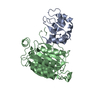 1nw9S C: citing same article ( S: Starting model for refinement |
|---|---|
| Similar structure data |
- Links
Links
- Assembly
Assembly
| Deposited unit | 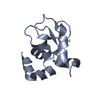
| |||||||||
|---|---|---|---|---|---|---|---|---|---|---|
| 1 |
| |||||||||
| Unit cell |
| |||||||||
| Components on special symmetry positions |
| |||||||||
| Details | The biological unit is a heterodimeric complex of CIAP1-BIR3 with N-terminal peptide from SMAC/DIABLO (AVPIAQ). |
- Components
Components
| #1: Protein | Mass: 11174.601 Da / Num. of mol.: 1 Source method: isolated from a genetically manipulated source Source: (gene. exp.)   Homo sapiens (human) / Gene: BIRC2, API1, IAP2, MIHB, RNF48 / Plasmid: pNAT40 / Production host: Homo sapiens (human) / Gene: BIRC2, API1, IAP2, MIHB, RNF48 / Plasmid: pNAT40 / Production host:   Escherichia coli (E. coli) / Strain (production host): BL21 DE3 / References: UniProt: Q13490 Escherichia coli (E. coli) / Strain (production host): BL21 DE3 / References: UniProt: Q13490 |
|---|---|
| #2: Protein/peptide |  Diablo homolog Diablo homologMass: 597.703 Da / Num. of mol.: 1 / Source method: obtained synthetically Details: peptide synthesized based on N-terminal fragment of SMAC/DIABLO (AVPIAQ). References: UniProt: Q9NR28*PLUS |
| #3: Chemical | ChemComp-ZN / |
| #4: Water | ChemComp-HOH /  Water Water |
-Experimental details
-Experiment
| Experiment | Method:  X-RAY DIFFRACTION / Number of used crystals: 1 X-RAY DIFFRACTION / Number of used crystals: 1 |
|---|
- Sample preparation
Sample preparation
| Crystal | Density Matthews: 2.8 Å3/Da / Density % sol: 56.15 % |
|---|---|
Crystal grow | Temperature: 293 K / Method: vapor diffusion, hanging drop / pH: 6.5 Details: 0.1 M BIS-TRIS PH 6.5, 0.2 M MGCL2, 22% PEG 3350, VAPOR DIFFUSION, HANGING DROP, temperature 293K |
-Data collection
| Diffraction | Mean temperature: 100 K |
|---|---|
| Diffraction source | Source:  ROTATING ANODE / Type: RIGAKU FR-E DW / Wavelength: 1.54 Å ROTATING ANODE / Type: RIGAKU FR-E DW / Wavelength: 1.54 Å |
| Detector | Type: RIGAKU RAXIS IV++ / Detector: IMAGE PLATE / Date: Jul 11, 2006 |
| Radiation | Protocol: SINGLE WAVELENGTH / Monochromatic (M) / Laue (L): M / Scattering type: x-ray |
| Radiation wavelength | Wavelength : 1.54 Å / Relative weight: 1 : 1.54 Å / Relative weight: 1 |
| Reflection | Resolution: 2.3→54.6 Å / Num. all: 6497 / Num. obs: 6193 / % possible obs: 95.4 % / Observed criterion σ(F): 1 / Observed criterion σ(I): 2 / Redundancy: 15.7 % / Biso Wilson estimate: 22.9 Å2 / Rmerge(I) obs: 0.191 / Net I/σ(I): 20.8 |
| Reflection shell | Resolution: 2.3→2.38 Å / Redundancy: 15.6 % / Rmerge(I) obs: 0.876 / Mean I/σ(I) obs: 4 / Num. unique all: 607 / % possible all: 96.8 |
- Processing
Processing
| Software |
| ||||||||||||||||||||||||||||||||||||
|---|---|---|---|---|---|---|---|---|---|---|---|---|---|---|---|---|---|---|---|---|---|---|---|---|---|---|---|---|---|---|---|---|---|---|---|---|---|
| Refinement | Method to determine structure : :  MOLECULAR REPLACEMENT MOLECULAR REPLACEMENTStarting model: PDB entry 1NW9 Resolution: 2.3→31.43 Å / Rfactor Rfree error: 0.01 / Data cutoff high absF: 309778.09 / Data cutoff low absF: 0 / Isotropic thermal model: RESTRAINED / Cross valid method: THROUGHOUT / σ(F): 0 / σ(I): 0 / Stereochemistry target values: Engh & Huber
| ||||||||||||||||||||||||||||||||||||
| Solvent computation | Solvent model: FLAT MODEL / Bsol: 38.1086 Å2 / ksol: 0.357278 e/Å3 | ||||||||||||||||||||||||||||||||||||
| Displacement parameters | Biso mean: 31.3 Å2
| ||||||||||||||||||||||||||||||||||||
| Refine analyze |
| ||||||||||||||||||||||||||||||||||||
| Refinement step | Cycle: LAST / Resolution: 2.3→31.43 Å
| ||||||||||||||||||||||||||||||||||||
| Refine LS restraints |
| ||||||||||||||||||||||||||||||||||||
| LS refinement shell | Resolution: 2.3→2.44 Å / Rfactor Rfree error: 0.027 / Total num. of bins used: 6
|
 Movie
Movie Controller
Controller


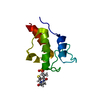

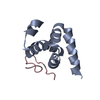

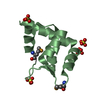


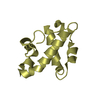


 PDBj
PDBj













